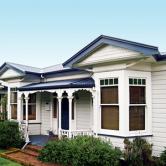Villa
The villa was the most common style built in New Zealand from the 1880s to the First World War. Typical features and materials include:
- construction almost entirely of timber
- one or two bay windows that face the street
- double hung sash sliding windows
- a veranda – often with fretwork decoration
- a piled subfloor
- internal brick fireplaces and chimneys
- hipped roof, typically 30–45o slope – sometimes with an internal gutter
- corrugated iron roof cladding
- rusticated weatherboard wall cladding – very early villas had overlapping boards
- facing boards to external corners and windows
- no insulation when built
- a high stud height – typically 3–3.6 metres
- air-leaky construction, leading to draughts and heat loss
- no mechanical ventilation in bathrooms or kitchens
- originally lined with scrim (sacking) and wallpaper over close butted boarding
- bathrooms added as a lean-to at the back of the house
- timber floorboards
MAINTENANCE FOR VILLAS
Regular maintenance required on villas includes:
- cleaning, checking and repainting the external cladding, which is most likely to be timber weatherboard. See the guide for external wall maintenance
- cleaning and checking the roof cladding, and recoating if necessary. See the guide for roof maintenance
- ensuring gutters and downpipes are kept clear of leaves and other debris. If necessary, prune back any tree branches that grow over the house
- checking that the subfloor space is dry and well-ventilated. See the guide for subfloor maintenance.
More extensive maintenance/repairs on villas may include:
- Adding roofspace insulation where there is none or the existing insulation is insufficient.
- Replacing missing or damaged subfloor insulation. Use insulation designed specifically for subfloors. This includes polystyrene friction-fitted between the joists and segments such as polyester, glass wool or sheep’s wool fixed with tabs or held in place by strapping. Press insulation firmly against the floor so there is no air movement between insulation and floor. With exposed subfloors, fix sheet material under the insulation to hold it securely in place.
- Checking the original brick chimney for strength – the original lime mortar loses strength and the chimney may collapse in an earthquake. The structural condition may need to be assessed by a chartered professional engineer. Removing an unsound brick chimney above the roofline does not require a building consent for any building up to 3 storeys high as long as the removal does not affect the primary structure, any specified system or any fire separation (which includes firewalls protecting other property). Making good the gaps left in a roof after chimney removal can also be done without a consent.
- Replacing missing or corroded fixings and connections between piles and bearers, and adding bracing between piles and bearers/joists for better earthquake resilience. See the subfloor maintenance guide for details.
- Checking for borer. Treat infested timber with a residual insecticide by brushing on or spraying surfaces. Using a small spray nozzle to inject the liquid into the holes is effective, but wear eye protection. Where the infestation is extensive or you are considering fumigation, consult a firm that is a member of the Pest Management Association of New Zealand.
- Checking for rot. If you find it, first identify and deal with the source of the moisture that has caused it. If it isn’t done, the problem could return. Remove all visible rot and at least one metre of timber beyond it. It may be easier to replace the entire piece of affected timber rather than trying to replace and strengthen a portion. Treat cut timber with a proprietary paint-on preservative.



